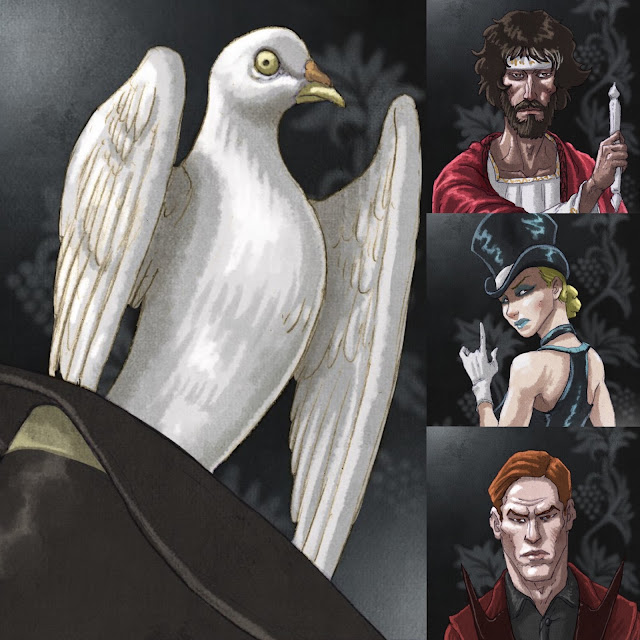The Four Senses of Draco Alchemicus
Good stories, like Ogres and onions, have layers. [1]
We are not sure how many layers Ogres and onions (or cakes) have, but thanks to Dante Alighieri (and, before him, John Cassian) we know good stories, like Scripture, have four: historical, allegorical, moral, and anagogical.
Are your eyes watering yet?
Dante Alighieri was, of course, the author of one of the greatest stories ever written (the Divine Comedy) so we may take him at his word that his own story had layers, but even Dante found that his readers needed help recognizing the layers through the tears. (Real Ogres cry.)
Accordingly, Dante (near rhyme with Donkey) found it necessary to explain to his friend Cangrande della Scala (near alliteration with Shrek) what those layers were:
For the sake, then, of clarifying what we have to say, it has to be understood that the meaning of this work [the Commedia] is not of one kind only [non est simplex sensus]; rather, it may be described as “polysemous”, as having, that is to say, several meanings [polysemos, hoc est plurium sensuum]; for the first meaning is that conveyed by the letter, while the next is that conveyed by what the letter signifies, the first of which we call the literal meaning, and the second the allegorical or mystical meaning.And for the better illustration of this way of conducting the argument we may take the following verses: “When Israel came out of Egypt and the house of Jacob from a barbarous people, Judah was his sanctuary and Israel his dominion.” [2] For if we consider the letter alone, what is signified is the coming out of the children of Israel from Egypt in the time of Moses; if, by contrast, the allegory, what is meant is our redemption through Christ; if, again, the moral sense, what is meant is the conversion of the soul from the sorrow and misery of sin to a state of grace; and if the anagogic, what is meant is the passing of the sanctified soul from the slavery of our present corruption to the liberty of our everlasting glory.And although these mystical meanings have various names, they may all of them in a general sense be termed allegorical, inasmuch as they are all of them different from the literal or historical meaning; for the word “allegory” is so called from the Greek “alleon”, which in Latin is “alienum” or “diversum.” [3]
Don’t you wish you had some parfait so as to map the layers? Or maybe some cake?
Fairy tales, including fairy tales about Ogres, are good stories, so they have layers, too, although in most modern readings they have only two: the literal or historical (including efforts to discover the “real” or original version of the story) and the psychological (a.k.a. how they are always already about sex).
To be fair, modern scholarship has done the same thing to the Scriptures: the Gospels are either mined as sources for the life of the historical Jesus or read for evidence that Jesus was gay. [4] But fairy tales have been known to carry a psychological layer ever since Freud. Think Oedipus, with a Sphinx instead of a donkey. (Donkeys love riddles.)
Back in college between courses on the letters of Paul, the synoptic Gospels, and the historical Jesus, I took a course in Gender Studies for which I did a paper on fairy tales, which meant reading Bruno Bettelheim’s The Uses of Enchantment (1975). You will be familiar with Bettelheim’s argument even if you have never read him. Tl;dr: Fairy tales are about coping with trauma. And, of course, sex.
(Shrek just wanted to recover his swamp from the fairy-tale refugees, remember?! But then he fell in love with Fiona.)
Layers, you see, are metaphysical realities, which is why onions are so hard to peel. How many you can count depends on your sensitivity to peas, not to mention quests and riddles. It also depends on your willingness to be baptized and transformed by Christ.
Which is perhaps why some people, unlike Ogres, can see only two (the literal and the psychological, a.k.a. sex).
The great Alexandrian exegete Origen (d. 254) read the Song of Songs—on the surface, a series of poems about, you guessed it, sex—as a drama with four main parts in as many layers: “This little book is an epithalamium, that is a nuptial song, which it seems to me that Solomon wrote in dramatic form, and sang after the fashion of a bride to her bridegroom, who is the word of God [sermo Dei], burning with celestial love. Indeed, he loves her deeply, whether she is the soul, made in his own image, or the Church.” [5]
Throughout the Middle Ages, this is the way Christian exegetes read the Scriptures: as a love song between God and his bride, whether his Church, his mother Mary, or the human soul. (Trust me on this, I have bibliography.) Christian readers expected Scripture to open out into layers and layers, like an art fair blooming onion. They also expected some of those layers to bring them to tears. Think eucatastrophe, with a side order of meditation on the Passion.
I know, you thought medieval Christianty was a swamp, when in fact it was a blooming onion.
If only someone would write stories like Ogres again. With layers. And tears.
Can you solve the riddle and read the signs?
dragoncommonroom.com
[1] Allusion to Shrek (2001).
[2] Citation of Psalm 113:1-2 (Vulgate numbering).
[3] Epistole 13.7, cited by John Took, Dante (Princeton: Princeton University Press, 2020), 529n9.
[4] Yes, really. See the controversy over Morton Smith’s The Secret Gospel of Mark (1973). Smith read the nakedness of the young man in the linen garment as a reference to a secret initiatory rite involving baptism, magic, and hypnotism (according to Wikipedia), but musicologist Peter Jeffrey insisted that Smith’s imagination had run away with him, just like the young man ran away in Mark 14:51-52. It’s complicated. Sort of.
[5] As translated into Latin by Rufinus of Aquileia, and into English by me, according to the footnotes in my PhD thesis.









Comments
Post a Comment
Thank you for taking the time to respond to my blog post. I look forward to hearing what you think!
F.B.